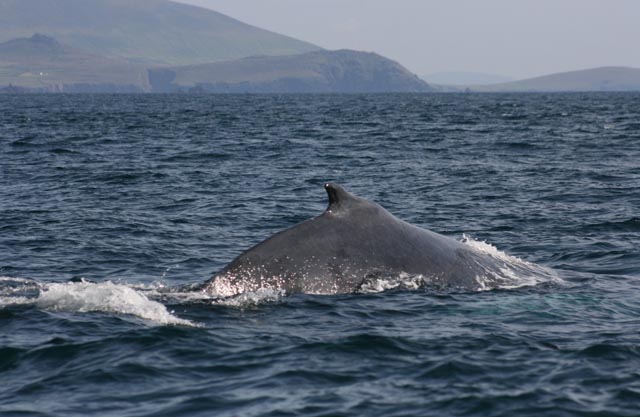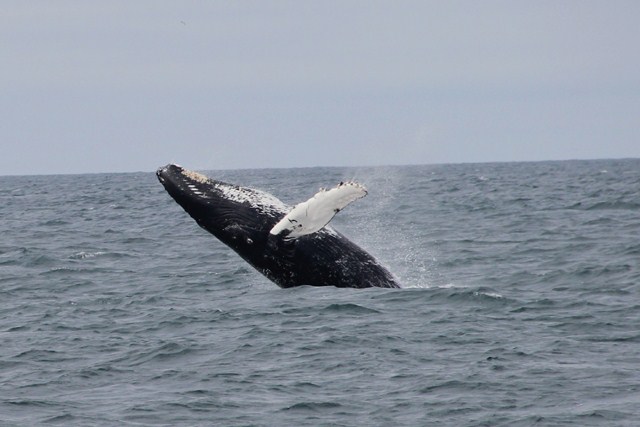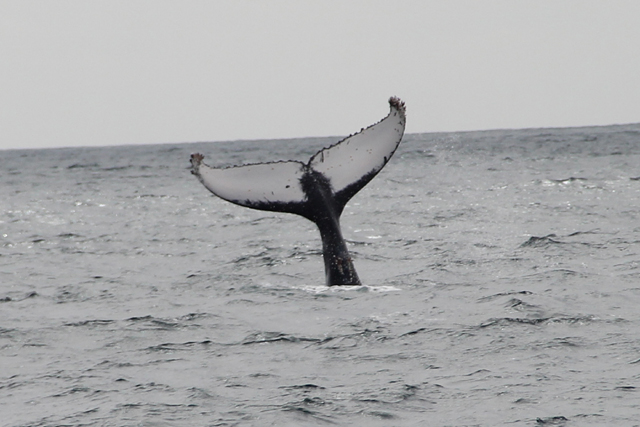A humpback whale called "Spot" and a talisman called Mickey Finn


Humpback whale HBIRL24 breaching off West Kerry, (c) Britta Wilkens

Identifiction fluke shot from humpback whale HBIRL24, (c) Britta Wilkens
Video
A humpback whale called "Spot", a talisman called Mickey Finn, and Nick - the man behind the telescope.
I had a good feeling when we set out for our afternoon tour on the last day of May Saturday, May 31st, 2014 departing from the pier at Ventry Harbour at 13:00 hrs. for our afternoon tour around the Blasket Islands. There were two good reasons for the good cheer. The first was the fact that our friend Nick Masset had spotted two humpback whales midway between Sybil Head and Inish Tuaisceart [ Dead Man Island, also called The Sleeping Giant] and had given me the approximate co-ordinates from his perch on Clogher Head which turned out later to be very accurate dead reckoning. The second reason that I was in good cheer was the fact that I reckoned we had a talisman on board in the person of a man called Mickey Finn who himself was a sea captain from across the pond, from Annapolis on the east coast of America. Previous to this the only "Mickey Finn" I had heard about was a cocktail mix and being a litle bit inclined to the superstitious side I was now more than ever inclined to show this real live Mickey Finn a good trip.
"Blow! 3miles ahead on the starboard bow!"
Having picked up the passengers from the Great Blasket Island that we left there on the morning tour we continued on in the direction of Nick's co-ordinates and it wasn't long before someone sang out "Blow!" from the flying bridge. Then in the distance he started to breach coming clean out of the water numerous times. Then a second humpback started breaching close by the first. I took a bearing on one animal and 20 minutes later we were close by which meant that we had been about 3 miles distant when first spotted as we do a steady 9 kts. on Blasket Princess in order to leave as small a footprint as possible for our tours. All the while as we approached, the humpback whale was breaching continuously and as we approached he started to wave us on with one pectoral fin waving in the air! More amazing still when we were closer to him he began to do the backstroke! lying on his back and swimming backwards using both his long pectoral fins alternatively as paddles! It was quite simply amazyballs!
Finally he started slapping the water with his tail flukes [ usually a sign that he wants us to clear off even though we stayed a respectable distance away from him] and giving us an amazing opportunity to take photo id shots of the underside of his tail fluke where the colouration pattern is used to "tail print" and identify each individual humpback whale for the Irish Humpback Whale Catalogue.
Humpback whales sometimes use this method of slapping the tail repeatedly on the water surface, called lobtailing or kick feeding, to create bubbles or stun prey near the surface prior to lunge feeding. Another way to help identify individual humpback whales or extended related pods is by their fishing techniques, some employing bubble clouds to confuse shoals of prey , others [including individuals frequenting Blasket islands waters] weave sophisticated nets by blowing bubbles in a spiraling fashion as they ascend to the surface and then gulping at the trapped fish at the surface with extended jaws (lower jaw in particular). As only a minority of North Atlantic humpback whales employ this technique this should be an added help in trying to find out where our Irish Humpback whales go to breed, which is still unknown, but may be off the West Indies - possibly someplace like The Silver Bank, 70 mls. north of the Dominican Republic and 70 mls. south east of Turks and Caicos Islands - a long way from The Silver Strand [ An Trá Bán ] on the Blaskets! This method of identification is complicated further by the fact that when at the breeding grounds they are solely preoccupied with mating rather than feeding.
Humpback whale identification from Irish Whale and Dolphin Group Catalogue www.iwdg.ie
Modern technology is such that within minutes we were able to identify the animal as "Spot" more mundanely called HBIRL24 on the Irish Humpback Whale Catalogue. We were able to do this by zooming in on the image of the underside of the tail fluke on the camera screen and comparing that image with images from the catalogue displayed on a smart phone screen placed alongside. It was obvious it was "Spot", so called from a little dark spot on the right inside of his left white tail fluke colouration pattern and an animal which was last previously sighted around the Blaskets in August / September, 2013. Coincidentally an animal with similar behavioural characteristics [ i.e. a fondness for the backstroke and waving the pectoral fin] has recently been sighted off Dursey Island on June 21st, 2014. The animal accompanying Spot around the Blaskets was later identified as HBIRL23.
"All records are validated and available on www.iwdg.ie".
That evening we were a little late returning from our trip but there were a lot of happy smiley faces around. When we reached the pier at Ventry Harbour, Nick - the man who put us on the humpback whale - was there to greet us and we organised three cheers for him from all the passengers and I wished our talisman Mickey Finn and family the best of luck on his future travels. That's what it takes to catch a humpback - a lot of patience, suitable sea and weather conditions, a lot of time at field research and observation, a lot of skill and knowledge and a bit of luck.
Please do not expect to see a humpback whale on each of our trips! It's a Nature Lottery, the jackpot only comes up every now and then but if you are not in you can't win so please press the "BOOK TOUR" button now on our homepage to be in with a chance.
Apart from the odd humpback whale like"Spot", Dingle Bay is hopping at the moment with harbour porpoises, usually observed in sea state 2 or less, with 30 animals sighted in one day of 20 separate sightings, and 13 Minke whales observed on one day of research survey.
LATEST NEWS:
27.06.2014 There are 4 separate blows visible by telescope about 15 miles distant on the horizon from Slea Head so we hope to search for more humpbacks on next suitable days which may be Sunday 29th, June 2014 and Tuesday, 1st July, 2014
13.07.2014 Most of the whale and dolphin activity since has been around the Skellig islands, on the south side of Dingle Bay, Co. Kerry with reports of Minke whales lunge feeding shoals of small fish against the steep sided shore of the Skellig Rock and blows still reported just tantalisingly outside our range. A fishing friend has given us a sighting of "four large very active whales" but the weather is unsettled and overcast to foggy and we hope that when we get settled weather again and good visibility that we will find that some of our humpback friends from last year will have come back to visit, as site fidelity is common to humpbacks and also transferred from generation to generation, once the prey stock is not depleted of course!
Hope to see you then! Captain Whales Galore















